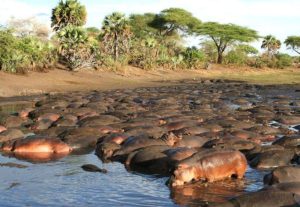Exploring Nyerere National Park in February
Nyerere National Park, formerly known as Selous Game Reserve, is one of Tanzania’s largest and oldest protected areas. Covering an impressive 50,000 square kilometers, the park is home to a diverse array of wildlife, including elephants, lions, giraffes, and hippos. February is an excellent time to visit Nyerere National Park, as the rainy season is coming to an end, and the landscape is lush and green.
February Weather at Nyerere National Park
In February, the weather at Nyerere National Park is warm and humid, with temperatures averaging around 30 degrees Celsius during the day. The rainy season starts to taper off, but visitors should still be prepared for occasional showers. The park’s rivers and lakes are full, making it a great time to see wildlife congregating around the water sources.
Visitors should pack light clothing, as well as a rain jacket or poncho for unexpected downpours. It is also advisable to wear sturdy walking shoes for game drives and bush walks. The park’s vegetation is lush and green in February, providing a picturesque backdrop for wildlife viewing and photography.
Must-See Attractions for February Visitors
-
Boat Safari on the Rufiji River: The Rufiji River is the lifeblood of Nyerere National Park, providing water for a variety of wildlife. A boat safari on the river allows visitors to see crocodiles, hippos, and a wide range of bird species up close. The riverbanks are also home to elephants, giraffes, and buffaloes, making it a must-see attraction for February visitors.
-
Walking Safaris: Nyerere National Park offers guided walking safaris, allowing visitors to explore the park on foot and get closer to nature. In February, the park’s vegetation is thick and green, providing a unique opportunity to see wildlife in their natural habitat. Walking safaris are led by experienced guides who are knowledgeable about the park’s flora and fauna.
-
Game Drives: Game drives are a popular activity in Nyerere National Park, allowing visitors to see a wide variety of wildlife, including lions, leopards, and elephants. In February, the park’s grasslands are green and lush, providing a stunning backdrop for wildlife viewing. Game drives are best done in the early morning or late afternoon when animals are most active.
-
Fly Camping: For those looking for a more adventurous experience, fly camping is a unique way to spend a night under the stars in the heart of the park. Visitors can enjoy a traditional bush dinner and campfire, surrounded by the sounds of the African wilderness. Fly camping is organized by Sunset Africa Safari, and for booking requests, clients can contact info@sunsetafricasafari.com.
In conclusion, February is an excellent time to explore Nyerere National Park, with its warm weather and lush vegetation providing the perfect backdrop for wildlife viewing. From boat safaris on the Rufiji River to guided walking safaris, there is no shortage of activities to enjoy in this stunning park. For an unforgettable safari experience, be sure to book a tour with Sunset Africa Safari and immerse yourself in the beauty of Nyerere National Park.


